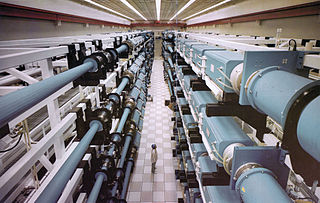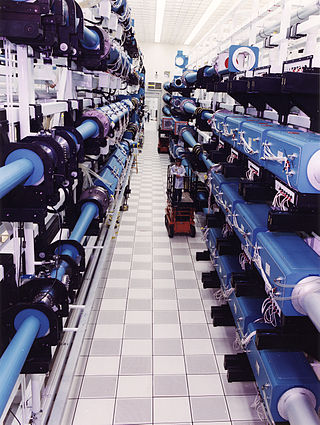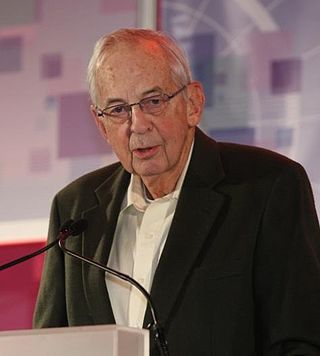Related Research Articles
Lawrence Livermore National Laboratory (LLNL) is a federally funded research and development center in Livermore, California, United States. Originally established in 1952, the laboratory now is sponsored by the United States Department of Energy and administrated by Lawrence Livermore National Security, LLC.

Inertial confinement fusion (ICF) is a fusion energy process that initiates nuclear fusion reactions by compressing and heating targets filled with fuel. The targets are small pellets, typically containing deuterium (2H) and tritium (3H).

The National Ignition Facility (NIF) is a laser-based inertial confinement fusion (ICF) research device, located at Lawrence Livermore National Laboratory in Livermore, California, United States. NIF's mission is to achieve fusion ignition with high energy gain. It achieved the first instance of scientific breakeven controlled fusion in an experiment on December 5, 2022, with an energy gain factor of 1.5. It supports nuclear weapon maintenance and design by studying the behavior of matter under the conditions found within nuclear explosions.

Nova was a high-power laser built at the Lawrence Livermore National Laboratory (LLNL) in California, United States, in 1984 which conducted advanced inertial confinement fusion (ICF) experiments until its dismantling in 1999. Nova was the first ICF experiment built with the intention of reaching "ignition", a chain reaction of nuclear fusion that releases a large amount of energy. Although Nova failed in this goal, the data it generated clearly defined the problem as being mostly a result of Rayleigh–Taylor instability, leading to the design of the National Ignition Facility, Nova's successor. Nova also generated considerable amounts of data on high-density matter physics, regardless of the lack of ignition, which is useful both in fusion power and nuclear weapons research.

David Jeffrey Wineland is an American Nobel-laureate physicist at the National Institute of Standards and Technology (NIST) physics laboratory. His work has included advances in optics, specifically laser-cooling trapped ions and using ions for quantum-computing operations. He was awarded the 2012 Nobel Prize in Physics, jointly with Serge Haroche, for "ground-breaking experimental methods that enable measuring and manipulation of individual quantum systems".

Edward Moses is an American physicist and is the former president of the Giant Magellan Telescope Organization. He is a past principal associate director for the National Ignition Facility & Photon Science Directorate, where he led the California-based NIF, the largest experimental science facility in the US and the world's most energetic laser, that hopes to demonstrate the first feasible example of usable nuclear fusion.

James Power Gordon was an American physicist known for his work in the fields of optics and quantum electronics. His contributions include the design, analysis and construction of the first maser in 1954 as a doctoral student at Columbia University under the supervision of C. H. Townes, development of the quantal equivalent of Shannon's information capacity formula in 1962, development of the theory for the diffusion of atoms in an optical trap in 1980, and the discovery of what is now known as the Gordon-Haus effect in soliton transmission, together with H. A. Haus in 1986. Gordon was a member of the National Academy of Engineering and the National Academy of Sciences.
Michael Dennis Feit (1942-2023) was an American physicist at the Lawrence Livermore National Laboratory, California.
John F. Holzrichter is an American physicist, formerly the President of the Hertz Foundation, and currently a Fellow of the American Association for the Advancement of Science.
Tihiro Ohkawa was a Japanese physicist whose field of work was in plasma physics and fusion power. He was a pioneer in developing ways to generate electricity by nuclear fusion when he worked at General Atomics. Ohkawa died September 27, 2014 in La Jolla, California at the age of 86.
Félicie Albert is a French-born American physicist working on laser plasma accelerators. She is the deputy director for the Center for High Energy Density Science at Lawrence Livermore National Laboratory and staff scientist at the National Ignition Facility and Photon Science Directorate and the Joint High Energy Density Sciences organization. She received BS in 2003 in engineering from Ecole Nationale Supérieure de Physique de Marseille, in France, her master's degree in optics from the University of Central Florida in 2004 and her PhD from Ecole Polytechnique in 2007, before joining LLNL as a postdoctoral fellow in 2008. Her main expertise are "the generation and applications of novel sources of electrons, X-rays and gamma-rays through laser-plasma interaction, laser-wakefield acceleration and Compton scattering."
Dmitri Dmitriyevich Ryutov is a Russian theoretical plasma physicist.
John D. Lindl is an American physicist who specializes in inertial confinement fusion (ICF). He is currently the chief scientist of the National Ignition Facility at the Lawrence Livermore National Laboratory.
Kunioki Mima is a Japanese plasma physicist. He is known for his contributions to the theory of turbulent transport in plasmas, and in particular the derivation of the Hasegawa–Mima equation in 1977, which won him the 2011 Hannes Alfvén Prize.

Kimberly Susan Budil is an American physicist who is the 13th and current director of Lawrence Livermore National Laboratory, making her the first woman to hold this position. She completed her bachelor's degree in physics from the University of Illinois Chicago, and her master's and doctorate in applied science from the University of California, Davis. She collaborated with Nobel laureate Donna Strickland, and made significant contributions to the field of high-power, ultra-fast lasers. Starting her career at Lawrence Livermore National Laboratory in 1987, she held various roles across government departments, including the Department of Energy and the Department of Defense. In 2014, she managed relations between the University of California's campuses and the three Department of Energy labs it manages. Budil, who was made a fellow of the American Physical Society in 2019, has also been a prominent advocate for women in science.
Christine Garban-Labaune is a French plasma physicist known for her research in inertial confinement fusion.
Tammy Ma is an American plasma physicist who works on inertial confinement fusion at the Lawrence Livermore National Laboratory.
Sharon Gail Glendinning is an American experimental physicist.
Denise Hinkel is a plasma physicist at Lawrence Livermore National Laboratory.
Andrea "Annie" Kritcher is an American nuclear engineer and physicist who works at the Lawrence Livermore National Laboratory. She was responsible for the development of Hybrid-E, a capsule that enables inertial confinement fusion. She was elected Fellow of the American Physical Society in 2022.
References
- ↑ "APS Fellow Archive". APS. Retrieved 20 September 2020.
- "David Herbert Munro." Marquis Who's Who TM. Marquis Who's Who, 2009. Fee (via Fairfax County Public Library). Reproduced in Biography Resource Center. Farmington Hills, Michigan.: Gale, 2009. http://galenet.galegroup.com/servlet/BioRC. Accessed 2009-10-22. Document Number: K2015715582.